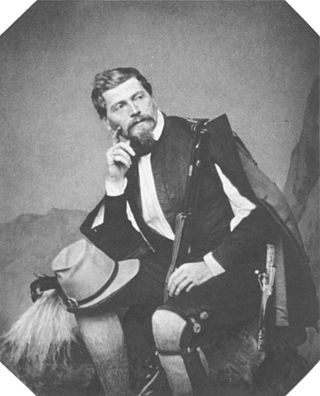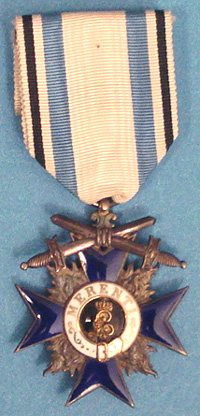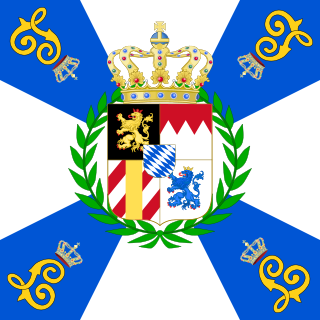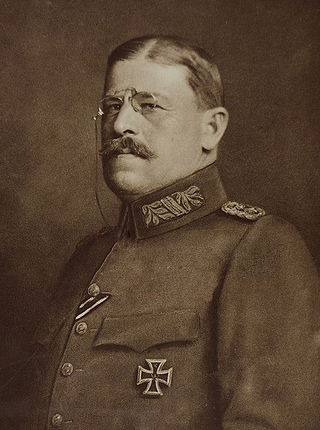
Ludwig Samson Heinrich Arthur Freiherr von und zu der Tann-Rathsamhausen was a Bavarian general.

Ludwig III was the last King of Bavaria, reigning from 1913 to 1918. Initially, he served in the Bavarian military as a lieutenant and went on to hold the rank of Oberleutnant during the Austro-Prussian War. He entered politics at the age of 18 becoming a member of the Bavarian parliament and was a keen participant in politics, supporting electoral reforms. Later in life, he served as regent and de facto head of state from 1912 to 1913, ruling for his cousin, Otto. After the Bavarian parliament passed a law allowing him to do so, Ludwig deposed Otto and assumed the throne for himself. He led Bavaria during World War I. His short reign was seen as championing conservative causes and he was influenced by the Catholic encyclical Rerum novarum.

Chlodwig Carl Viktor, Prince of Hohenlohe-Schillingsfürst, Prince of Ratibor and Corvey, usually referred to as the Prince of Hohenlohe, was a German statesman, who served as the chancellor of the German Empire and minister-president of Prussia from 1894 to 1900. Prior to his appointment as Chancellor, he had served in a number of other positions, including as minister-president of Bavaria (1866–1870), German Ambassador to Paris (1873–1880), Foreign Secretary (1880) and Imperial Lieutenant of Alsace-Lorraine (1885–1894). He was regarded as one of the most prominent liberal politicians of his time in Germany.

Kurt Gebhard Adolf Philipp Freiherr von Hammerstein-Equord was a German general (Generaloberst) who was the Commander-in-Chief of the Reichswehr, the Weimar Republic's armed forces. He is regarded as "an undisguised opponent" of Adolf Hitler and the Nazi regime.
Jakob Ritter von Danner was a general in the Royal Bavarian Army, the Imperial German Army and the Reichswehr. As commandant of the Munich garrison of the Reichswehr, he was a central figure in putting down the attempted Beer Hall Putsch by Adolf Hitler and the Nazis in 1923.
The 1st Royal Bavarian Division was a unit of the Royal Bavarian Army that served alongside the Prussian Army as part of the Imperial German Army. The division was formed on November 27, 1815, as the Infantry Division of the Munich General Command. It was called the 1st Army Division between 1822 and 1848, again between 1851 and 1859, and again from 1869 to 1872. It was called the 1st Infantry Division from 1848 to 1851 and was named the Munich General Command from 1859 to 1869. From April 1, 1872, until mobilization for World War I, it was the 1st Division. Within Bavaria, it was not generally referred to as a "Royal Bavarian" division, but outside Bavaria, this designation was used for it, and other Bavarian units, to distinguish them from similarly numbered Prussian units. The division was headquartered in Munich from 1815 to 1919. The division was part of the 1st Royal Bavarian Army Corps.
The 4th Division was a unit of the Prussian/German Army. It was formed in Torgau on September 5, 1818. The headquarters moved to Stargard in 1820, where it stayed until 1852. In 1852, the headquarters moved to its final destination, Bromberg. From the corps' formation in 1820, the division was subordinated in peacetime to the II Army Corps. The 4th Division was disbanded in 1919 during the demobilization of the German Army after World War I.

The Bavarian Military Merit Order was established on 19 July 1866 by King Ludwig II of Bavaria. It was the kingdom's main decoration for bravery and military merit for officers and higher-ranking officials. Civilians acting in support of the army were also made eligible for the decoration. The Military Merit Order ranked below the Military Order of Max Joseph (Militär-Max-Joseph-Orden), which was Bavaria's highest military honor for officers.

Eugen Siegfried Erich Ritter von Schobert was a German general during World War II. He commanded the 11th Army during Operation Barbarossa, the invasion of the Soviet Union. Schobert died when his observation plane crashed in a Soviet minefield.

Felix Ludwig Grafvon Bothmer was a German general from Bavaria. He notably served in the Brusilov offensive of World War I.

The Bavarian Army was the army of the Electorate (1682–1806) and then Kingdom (1806–1918) of Bavaria. It existed from 1682 as the standing army of Bavaria until the merger of the military sovereignty of Bavaria into that of the German State in 1919. The Bavarian Army was never comparable to the armies of the Great Powers of the 19th century, but it did provide the Wittelsbach dynasty with sufficient scope of action, in the context of effective alliance politics, to transform Bavaria from a territorially-disjointed small state to the second-largest state of the German Empire after Prussia.

AdolfRittervon Heinleth was a Bavarian General der Infanterie and War Minister under Ludwig II of Bavaria and under Otto of Bavaria.

Oskar Ritter und Edlervon Xylander was a Bavarian General der Infanterie, at last commanding the I Royal Bavarian Corps until his retirement in 1918.
Christian Grafvon Forbach, then Christian Marquis de Deux-Ponts and later Christian Freiherrvon Zweibrücken was an officer of the French Army and later a general of the Royal Prussian and then of the Bavarian Army, at last in the rank of General der Infanterie. He should not be confused with his nephew Christian Freiherr von Zweibrücken, who was a Bavarian General of Cavalry.
Hans Rittervon Hemmer, was a general staff officer in the Royal Bavarian Army. A highly decorated veteran of World War I, he was a recipient of both the Knight's Cross and the Commander's Cross of the Military Order of Max Joseph, the Kingdom of Bavaria's highest military honor, as well as the Pour le Mérite, the Kingdom of Prussia's highest military honor.

The Order of Merit of the Prussian Crown was an award of civil and military merit established 18 January 1901 by King Wilhelm II on the occasion of the bicentennial of the establishment of the Kingdom of Prussia. The order was presented in one class and consisted of a badge and a breast star. For military merit the award was presented with crossed swords. The order was presented once with diamonds.

Jakob Freiherr von Hartmann was a Bavarian general who served in the Austro-Prussian War and Franco-Prussian War.
The General Honour Decoration was a civil and military decoration of the Grand Duchy of Hesse. Established 25 September 1843, the medal could be awarded to recognize several different accomplishments or merits, such as military merit, lifesaving and long service. The reason for the award of the medal was determined by the inscription on the reverse of the medal, with the obverse bearing the effigy of the reigning Grand Duke of Hesse.

Schloss Hundshaupten is a quadrangular castle in the village of Hundshaupten in the municipality of Egloffstein in the German county of Forchheim.

Oskar Freiherr von Zoller was a Bavarian Lieutenant general who was known for serving at the Battle of Kissingen during the Austro-Prussian War, being killed during the fighting.














